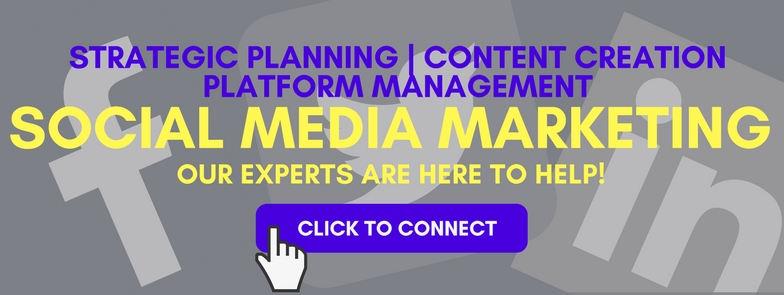
You want to grow your brand and build name recognition for your business. But you don’t have much of a budget and just getting started gives you anxiety. Does this sound familiar? We get it!
Marketing yourself or your business can seem like an overwhelming feat – like one that only big businesses can afford to do. Here’s the good news: You don’t need a lot of money to build your online presence – especially when using social media. You need the right strategy and you need time. Yes, we know, time is money, so we’ll walk you through how to build that strategy so that you’re investing your time wisely.
Step one: just get started.
The first step in building your online footprint is to create business profiles on social media. For most businesses, we recommend starting on Facebook, LinkedIn and Twitter. Depending on your industry and target audience, you may also consider an Instagram account. All of these accounts are free to set up and there are tutorials available to walk you through the best steps to optimize each account.
If you’re not sure whether you can manage pages on every platform, then start with LinkedIn and Facebook. You don’t have to be on every platform, especially when you’re getting started. You want to pick the platform where you can best reach your target audience, then work on mastering your content there first. If you spread yourself too thin, you could turn people away from your brand.
Recent blog: 5 Foolproof Social Media Tips for 2018.
Reconnaissance Mission
Once you have those profiles setup, it’s time to do a little research. We jokingly refer to this data collection and observation as a bit of “friendly stalking”. Start by checking out your competition and other industry sources.

- What are your competitors doing online?
- How are they crafting their content?
- Which posts seem to attract the most engagement?
- What are they doing well — and what areas are open for you to do better?
Also take a close look at your target audience.
- What pages and posts do they follow?
- What information are they looking for that you can provide?
- What are they posting that you can support by liking and sharing their content?
- Which groups are they in?
For example, if you are a real estate agent looking to add to your client base, look for mortgage brokers, moving companies, home inspection companies, real estate attorneys, title companies and any professional groups where you may be able to join the conversation and eventually gain referrals. When you are genuine about your interaction and involvement — whether through your posts or engagement in groups — then you can begin to build online relationships.
Let’s take a moment to clarify the word “stalker.” We definitely do not mean this in the definitive sense! We simply mean to observe, often silently, and make notes of the behavior. Only interact (like, share, comment) with pages and posts that make sense. At this stage, the more important thing is to be learning — a very valuable and often missed step. Before you can lead the conversation online, you first need to know what’s already being said.
Think of it this way. If you attend a dinner party and you overhear an interesting conversation between people you don’t know, you’re not likely going to chime in uninvited. Frankly, it’s rude and doesn’t give a good first impression. Instead, you’d likely ease your way over to the group and introduce yourself kindly. Party etiquette works the same way online.
Content. Content. Content.
Now that your profiles are up and you’ve started to get a real feel for what is being posted online, it’s time to start thinking about and planning your own content.
SEO. Hashtags. Metadata. Online marketing buzz can be a tad overwhelming when you’re just getting started. Here’s what you really need to know: The more good content you push out, the better. You widen your net, grow your base, expose your brand and you’re more easily found online with content.
But what is good content? What content counts?
The good news is that anything you write that’s on topic, relevant, and timely to your audience is considered good content. Don’t get hung up on thinking it’s high school English class all over again. There’s no need for an intro paragraph, three supporting paragraphs and then a conclusion. Life online is much simpler. Crisper. Fun.
Content is also not just words on a page. It can be a picture or video with tags. Shared content – from a media outlet, fellow business owner, industry organizations. A precise article for LinkedIn. A press release you’ve sent to the media and posted on your website. Content, especially in the beginning, should not add stress to your already busy day.
Here’s an example: You go to a Chamber lunch to meet other business owners in your community.
 While at this luncheon, snap a pic — maybe it’s of your table, maybe it’s of the speaker, maybe it’s in front of the buffet. Then post the photo to LinkedIn. Along with the picture, write a post thanking the host and mentioning something you learned or liked at the event. Tag the organization. Consider adding a hashtag, which helps your post be more easily found by those who aren’t yet following you.
While at this luncheon, snap a pic — maybe it’s of your table, maybe it’s of the speaker, maybe it’s in front of the buffet. Then post the photo to LinkedIn. Along with the picture, write a post thanking the host and mentioning something you learned or liked at the event. Tag the organization. Consider adding a hashtag, which helps your post be more easily found by those who aren’t yet following you.
Hopefully you exchanged cards with every person at your lunch table. That’s likely seven people you can now reach out to on LinkedIn, thanking them for a pleasant lunch. And now you can connect with them and follow their company, adding to your own network and followers online.
So, for the cost of a chicken and capers lunch you’ve just marketed your brand. A couple of good, productive hours of marketing. Remember, marketing shouldn’t be an add-on or a chore. It should be part of your day. A foundational step to grow your business. And the more you start to think about it in this way, the less time consuming digital marketing will be, and the more that it will pay off.
Where to find post ideas.
You’re a subject matter expert for your business and it’s important your online circle knows you know what you’re talking about.
If you’re a planner, consider writing down article topics on a list. Factor in seasons, holidays, anything that could make the topic even more noteworthy. Pin that list up in your office and commit to writing once at least once each week. If you really like to plan ahead, come up with 12 themes to help give you focus, one theme each month, for the full year. This is the beginning of a content calendar for your business.
Holidays. Charitable outreach projects you’re doing. National trends that you can localize. Don’t beat yourself up if you don’t have “original” ideas in the beginning. They’ll come. Take the time to stay abreast with your industry and community. Follow your local media. See what you can convert to boost your own role in your town.
Listen to podcasts related to your business. See what books are trending on Amazon and the New York Times. See what national organizations in your industry are talking about on social media. Take what they say and make it your own.
Writing it down.
 Using the real estate professional example we started with, you may want to blog about how to prep your house for a sale. Or which home improvement projects are worth the money. Or, how to choose a mortgage broker. There’s plenty of content out there, you just have to believe in the topic and make it your own. Be sure you do not plagiarize. If you lift content, you have to give the original writer credit, and better yet, link back to the original article you’re pulling information from.
Using the real estate professional example we started with, you may want to blog about how to prep your house for a sale. Or which home improvement projects are worth the money. Or, how to choose a mortgage broker. There’s plenty of content out there, you just have to believe in the topic and make it your own. Be sure you do not plagiarize. If you lift content, you have to give the original writer credit, and better yet, link back to the original article you’re pulling information from.
Write a draft and have someone you trust (who preferably is not an expert on the topic) review it. You don’t want to post something that doesn’t make sense or has an error. Here’s where you need to be honest with yourself. Are you a writer? Knowing your strengths and hiring for your weaknesses is key when building your business. Of course, you are on a budget so hiring a content professional may be out of the question. You could always consider a college intern with strong writing skills. Often, students are looking for experience, but keep in mind that hiring someone, especially someone who is green, leaves you to manage that person. It’s your call on what to do, but make sure that your writing has been vetted by fresh eyes before you hit publish.
Is there too much content?
This is a good question. We often have people turn to us after they’ve burned out quickly because they were trying to post several times a day to several platforms. And we all have those connections who post so much that their posts become white noise – or you even just drop them all together.
The key is consistency. Depending on how many people you’re connected with, pick your top platform to be the most engaged. Then find your rhythm. It could be five times a week, it could be daily. It could be every other day. It could be as simple as sharing other people’s content a couple times a week and sprinkling in your own posts. Make sure you are posting enough to keep the conversation going. We recommend 4-5 times per week for strong brand awareness.
Need help piecing it all together? We can help! Don’t let online marketing become a pain point for your business. Social media is a powerful tool that allows you to build your brand, voice your expertise, and grow your business. Connect with our team at any time during this process.
LATEST BLOGS & RESOURCES
From A to Z: The Power of Fonts in Branding and Design
We see words around us all day, every day - on billboards and street signs and storefronts, on our computers, [...]
Out with the Old: The Anti-Trends Shaping Your 2024 Marketing Game Plan
Near the end of every year, our team puts our heads together and takes a close look at marketing trends [...]
It’s time to unwrap our 2024 Marketing Trends!
It’s the most wonderful time of the year: time for our look ahead to the upcoming marketing trends of the [...]
10 Lessons I’ve Learned Since Being Named One of Lansing’s “10 Over the Next Ten”
The room was buzzing. More hugs than handshakes were being exchanged among some of Lansing's brightest minds—a testament to relationships [...]





